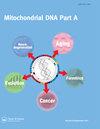Phylogeography of the endangered orchid Dendrobium moniliforme in East Asia inferred from chloroplast DNA sequences
IF 0.6
4区 生物学
Q4 GENETICS & HEREDITY
引用次数: 9
Abstract
Abstract The aim of the current study was to elucidate the phylogeographic history of Dendrobium moniliforme, an endangered orchid species, based on two chloroplast DNA (cpDNA) markers (trnC-petN and trnE-trnT). One hundred and thirty-five samples were collected from 18 natural populations of D. moniliforme covering the entire range of the Sino-Japanese Floristic Region (SJFR) of East Asia. A total of 35 distinct cpDNA haplotypes were identified in these populations, of which 23 haplotypes were each present in only one sample and thus restricted to a single population. The significantly larger NST value (0.586) than GST (0.328) (p < 0.05) demonstrated the presence of strong phylogeographic structure. Phylogenetic analyses indicated that all haplotypes were clustered into two lineages. The genetic diversity of D. moniliforme was high at the species level, reflected in its haplotype diversity (Hd=0.8862), nucleotide diversity (Pi=0.00361), total genetic diversity (HT=0.9011), and significant differentiation (ΦST=0.5482). Based on mismatch distribution analysis and neutrality tests, population expansion was evident in all sampled populations and also in all populations sampled in mainland China. Three refuge areas were identified, one each in southwestern China, central-southeastern China, and the CKJ (Taiwan, Japan and Korea) Islands. The results supported the hypothesis that glacial refugia were maintained on different spatial-temporal scales in the SJFR during the last glacial maximum or earlier cold periods, suggesting that Quaternary refugial isolation promoted allopatric speciation of D. moniliforme in East Asia.从叶绿体DNA序列推断东亚濒危兰花石斛的系统地理学
摘要本研究基于trnC-petN和trnE-trnT两个叶绿体DNA (cpDNA)标记,对濒危兰科植物石斛(Dendrobium moniliformme)的系统地理历史进行了研究。在东亚中日植物区(SJFR)的18个自然居群中采集了135份样品。在这些群体中共鉴定出35种不同的cpDNA单倍型,其中23种单倍型仅存在于一个样本中,因此仅限于一个群体。NST值(0.586)显著大于GST值(0.328)(p < 0.05),表明存在较强的系统地理结构。系统发育分析表明,所有的单倍型都聚集在两个谱系中。单倍型多样性(Hd=0.8862)、核苷酸多样性(Pi=0.00361)、总遗传多样性(HT=0.9011)和显著分化(ΦST=0.5482)在种水平上表现出较高的遗传多样性。根据错配分布分析和中性检验,种群扩张在所有样本种群中都很明显,在中国大陆的所有样本种群中也是如此。确定了三个保护区,分别位于中国西南部、中国中东南部和CKJ(台湾、日本和韩国)群岛。研究结果支持了在末次盛冰期或更早的冷期,冰川避难在不同时空尺度上维持的假设,表明第四纪避难隔离促进了东亚单胞菌的异域物种形成。
本文章由计算机程序翻译,如有差异,请以英文原文为准。
求助全文
约1分钟内获得全文
求助全文
来源期刊

Mitochondrial Dna Part a
Biochemistry, Genetics and Molecular Biology-Genetics
CiteScore
3.00
自引率
0.00%
发文量
6
期刊介绍:
Mitochondrial DNA Part A publishes original high-quality manuscripts on physical, chemical, and biochemical aspects of mtDNA and proteins involved in mtDNA metabolism, and/or interactions. Manuscripts on cytosolic and extracellular mtDNA, and on dysfunction caused by alterations in mtDNA integrity as well as methodological papers detailing novel approaches for mtDNA manipulation in vitro and in vivo are welcome. Descriptive papers on DNA sequences from mitochondrial genomes, and also analytical papers in the areas of population genetics, phylogenetics and human evolution that use mitochondrial DNA as a source of evidence for studies will be considered for publication. The Journal also considers manuscripts that examine population genetic and systematic theory that specifically address the use of mitochondrial DNA sequences, as well as papers that discuss the utility of mitochondrial DNA information in medical studies and in human evolutionary biology.
 求助内容:
求助内容: 应助结果提醒方式:
应助结果提醒方式:


